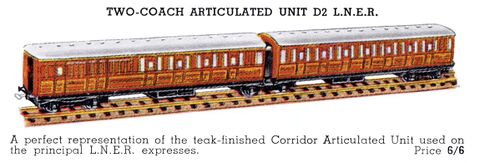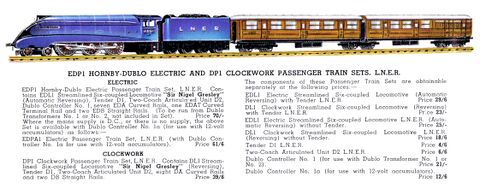Two-Coach Articulated Unit LNER 45401 45402 (Hornby Dublo D2)
| Exhibit |
|---|
Two-Coach Articulated Unit LNER 45401 45402 (Hornby Dublo D2) Teak LNER Two-Coach Articulated Unit, 1938 catalogue image (i) Teak LNER Two-Coach Articulated Unit, 1938 catalogue image (i)
|
 |
| location: |
|
Arch Four , Area 37 Hornby Wall (display) |
| Shelf 7 |
A pre-war wooden-effect (teak) brown LNER Two-Coach Articulated Unit (Hornby-Dublo D2) with white rounded-ended roofs, marked "45401" and "45402".
This was one of the original pieces in the Hornby Dublo range when it was launched in 1938, and it's appearance in the first Dublo passenger train set – a streamlined LNER luxury express train – sent a signal that Meccano Limited was aiming Dublo at the "quality" end of the 00-gauge market.
Naming
The model was assigned the suffix "D2", "D" for Dublo, and "2" to signify that this was a more expensive and more desirable item than the standard "D1" Dublo coach. Since most of the Dublo range range of rolling stock didn't really have "tiered" versions (there were D1 and D" signals to signify manual or electric operation), almost all the locos and rolling stock were effectively D1s, which made the naming system rather less useful than it might have been.
The Dublo range later went through two more numbering systems as the company tried to find the best way of identifying their items.
1938 catalogue image
Design
These two-coach units where unique to the LNER when they were first introduced. The two-coach units first appeared on the luxury Silver Jubilee trains, hauled by a silver A4-Class streamlined locomotive, and more of the double-carriages with a varnished teak finish were then added to other LNER A4-hauled luxury train services.
The principle of having two-coach units was that it helped make the ride smoother and less noisy – instead of having coach-ends that butted up against each other with their own independent wheel-bogies, so that the flush coach-ends would jiggle about with a shearing motion as each bogie passed over points and variations in the track, the new luxury coaches had pairs of coaches that shared a common bogie so that the coach-pair merely had a "hinging" action, with vibrations in one coach also being partially damped by the hinged connetion with with its partner.
Ideally these hinged joints would have been used for the full length of the train, but using hinged pairs was a tradeoff between having the best possible ride, and retaining flexibility over how coaches were assembled into trains.
The paired-coaches-with-central-shared-bogie concept was then borrowed by some of the coaches used on the ill-fated luxury red Coronation Scot 1939 train, which ended up being stranded in the US after a publicity tour when World War Two broke out, and which never saw service in the UK.
The idea wasn't generally adopted for contemporary "standard" coaches, presumably because railway controllers wanted to retain flexibility over the makeup of their trains, and wanted to be able to add or remove single coaches to a train service as and when required.




